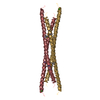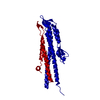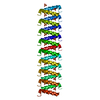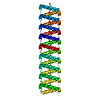+ Open data
Open data
- Basic information
Basic information
| Entry | Database: PDB / ID: 3iv1 | ||||||
|---|---|---|---|---|---|---|---|
| Title | Coiled-coil domain of tumor susceptibility gene 101 | ||||||
 Components Components | Tumor susceptibility gene 101 protein TSG101 TSG101 | ||||||
 Keywords Keywords |  HYDROLASE / COILED_COIL / HYDROLASE / COILED_COIL /  TUMORIGENESIS / CELL_CYCLE REGULATION / TUMORIGENESIS / CELL_CYCLE REGULATION /  Alternative splicing / Alternative splicing /  Cell cycle / Cell cycle /  Cell division / Cell division /  Coiled coil / Coiled coil /  Cytoplasm / Cytoplasm /  Endosome / Growth regulation / Host-virus interaction / Endosome / Growth regulation / Host-virus interaction /  Membrane / Membrane /  Nucleus / Nucleus /  Phosphoprotein / Polymorphism / Phosphoprotein / Polymorphism /  Protein transport / Transport / Ubl conjugation / Protein transport / Transport / Ubl conjugation /  Structural Genomics / Structural Genomics /  Structural Genomics Consortium / SGC Structural Genomics Consortium / SGC | ||||||
| Function / homology |  Function and homology information Function and homology informationpositive regulation of viral budding via host ESCRT complex / positive regulation of ubiquitin-dependent endocytosis / extracellular transport /  ESCRT I complex / negative regulation of epidermal growth factor-activated receptor activity / regulation of extracellular exosome assembly / ESCRT I complex / negative regulation of epidermal growth factor-activated receptor activity / regulation of extracellular exosome assembly /  viral budding / viral budding /  regulation of MAP kinase activity / exosomal secretion / protein transport to vacuole involved in ubiquitin-dependent protein catabolic process via the multivesicular body sorting pathway ...positive regulation of viral budding via host ESCRT complex / positive regulation of ubiquitin-dependent endocytosis / extracellular transport / regulation of MAP kinase activity / exosomal secretion / protein transport to vacuole involved in ubiquitin-dependent protein catabolic process via the multivesicular body sorting pathway ...positive regulation of viral budding via host ESCRT complex / positive regulation of ubiquitin-dependent endocytosis / extracellular transport /  ESCRT I complex / negative regulation of epidermal growth factor-activated receptor activity / regulation of extracellular exosome assembly / ESCRT I complex / negative regulation of epidermal growth factor-activated receptor activity / regulation of extracellular exosome assembly /  viral budding / viral budding /  regulation of MAP kinase activity / exosomal secretion / protein transport to vacuole involved in ubiquitin-dependent protein catabolic process via the multivesicular body sorting pathway / membrane fission / positive regulation of exosomal secretion / ubiquitin-dependent protein catabolic process via the multivesicular body sorting pathway / regulation of MAP kinase activity / exosomal secretion / protein transport to vacuole involved in ubiquitin-dependent protein catabolic process via the multivesicular body sorting pathway / membrane fission / positive regulation of exosomal secretion / ubiquitin-dependent protein catabolic process via the multivesicular body sorting pathway /  multivesicular body assembly / Flemming body / multivesicular body assembly / Flemming body /  virion binding / endosome to lysosome transport / negative regulation of epidermal growth factor receptor signaling pathway / viral budding via host ESCRT complex / autophagosome maturation / viral release from host cell / keratinocyte differentiation / Membrane binding and targetting of GAG proteins / Endosomal Sorting Complex Required For Transport (ESCRT) / virion binding / endosome to lysosome transport / negative regulation of epidermal growth factor receptor signaling pathway / viral budding via host ESCRT complex / autophagosome maturation / viral release from host cell / keratinocyte differentiation / Membrane binding and targetting of GAG proteins / Endosomal Sorting Complex Required For Transport (ESCRT) /  multivesicular body / HCMV Late Events / multivesicular body / HCMV Late Events /  ubiquitin binding / ubiquitin binding /  regulation of cell growth / regulation of cell growth /  macroautophagy / Late endosomal microautophagy / protein modification process / Budding and maturation of HIV virion / transcription corepressor activity / calcium-dependent protein binding / late endosome / late endosome membrane / early endosome membrane / macroautophagy / Late endosomal microautophagy / protein modification process / Budding and maturation of HIV virion / transcription corepressor activity / calcium-dependent protein binding / late endosome / late endosome membrane / early endosome membrane /  early endosome / endosome membrane / early endosome / endosome membrane /  regulation of cell cycle / regulation of cell cycle /  endosome / endosome /  cell cycle / cell cycle /  cell division / negative regulation of cell population proliferation / cell division / negative regulation of cell population proliferation /  centrosome / centrosome /  ubiquitin protein ligase binding / protein-containing complex binding / ubiquitin protein ligase binding / protein-containing complex binding /  nucleolus / negative regulation of transcription by RNA polymerase II / protein homodimerization activity / nucleolus / negative regulation of transcription by RNA polymerase II / protein homodimerization activity /  DNA binding / extracellular exosome / DNA binding / extracellular exosome /  plasma membrane / plasma membrane /  cytosol / cytosol /  cytoplasm cytoplasmSimilarity search - Function | ||||||
| Biological species |   Homo sapiens (human) Homo sapiens (human) | ||||||
| Method |  X-RAY DIFFRACTION / X-RAY DIFFRACTION /  SYNCHROTRON / SYNCHROTRON /  SAD / Resolution: 2.5 Å SAD / Resolution: 2.5 Å | ||||||
 Authors Authors | Neculai, D. / Avvakumov, G.V. / Wernimont, A.K. / Xue, S. / Walker, J.R. / Li, Y. / Weigelt, J. / Bountra, C. / Arrowsmith, C.H. / Edwards, A.M. ...Neculai, D. / Avvakumov, G.V. / Wernimont, A.K. / Xue, S. / Walker, J.R. / Li, Y. / Weigelt, J. / Bountra, C. / Arrowsmith, C.H. / Edwards, A.M. / Bochkarev, A. / Dhe-Paganon, S. / Structural Genomics Consortium (SGC) | ||||||
 Citation Citation |  Journal: To be Published Journal: To be PublishedTitle: Coiled-Coil Domain of Human Tsg101 Authors: Neculai, D. / Avvakumov, G.V. / Wernimont, A.K. / Xue, S. / Walker, J.R. / Li, Y. / Weigelt, J. / Bountra, C. / Arrowsmith, C.H. / Edwards, A.M. / Bochkarev, A. / Dhe-Paganon, S. | ||||||
| History |
|
- Structure visualization
Structure visualization
| Structure viewer | Molecule:  Molmil Molmil Jmol/JSmol Jmol/JSmol |
|---|
- Downloads & links
Downloads & links
- Download
Download
| PDBx/mmCIF format |  3iv1.cif.gz 3iv1.cif.gz | 254.4 KB | Display |  PDBx/mmCIF format PDBx/mmCIF format |
|---|---|---|---|---|
| PDB format |  pdb3iv1.ent.gz pdb3iv1.ent.gz | 220.3 KB | Display |  PDB format PDB format |
| PDBx/mmJSON format |  3iv1.json.gz 3iv1.json.gz | Tree view |  PDBx/mmJSON format PDBx/mmJSON format | |
| Others |  Other downloads Other downloads |
-Validation report
| Arichive directory |  https://data.pdbj.org/pub/pdb/validation_reports/iv/3iv1 https://data.pdbj.org/pub/pdb/validation_reports/iv/3iv1 ftp://data.pdbj.org/pub/pdb/validation_reports/iv/3iv1 ftp://data.pdbj.org/pub/pdb/validation_reports/iv/3iv1 | HTTPS FTP |
|---|
-Related structure data
| Similar structure data |
|---|
- Links
Links
- Assembly
Assembly
| Deposited unit | 
| ||||||||
|---|---|---|---|---|---|---|---|---|---|
| 1 | 
| ||||||||
| 2 | 
| ||||||||
| 3 | 
| ||||||||
| Unit cell |
|
- Components
Components
| #1: Protein |  TSG101 / ESCRT-I complex subunit TSG101 TSG101 / ESCRT-I complex subunit TSG101Mass: 9198.006 Da / Num. of mol.: 8 / Fragment: COILED-COIL DOMAIN Source method: isolated from a genetically manipulated source Source: (gene. exp.)   Homo sapiens (human) / Gene: TSG101 / Plasmid: PET28-LIC / Production host: Homo sapiens (human) / Gene: TSG101 / Plasmid: PET28-LIC / Production host:   Escherichia coli (E. coli) / Strain (production host): BL21(DE3) / References: UniProt: Q99816 Escherichia coli (E. coli) / Strain (production host): BL21(DE3) / References: UniProt: Q99816#2: Chemical | ChemComp-SO4 / |  Sulfate Sulfate#3: Chemical | ChemComp-CL /  Chloride Chloride#4: Water | ChemComp-HOH / |  Water Water |
|---|
-Experimental details
-Experiment
| Experiment | Method:  X-RAY DIFFRACTION / Number of used crystals: 1 X-RAY DIFFRACTION / Number of used crystals: 1 |
|---|
- Sample preparation
Sample preparation
| Crystal | Density Matthews: 2.12 Å3/Da / Density % sol: 42.11 % |
|---|---|
Crystal grow | Temperature: 291 K / Method: vapor diffusion, hanging drop / pH: 5.5 Details: 2.4 M AMMONIUM SULFATE, 0.1 M BIS-TRIS, 1 mM DTT, pH 5.50, VAPOR DIFFUSION, HANGING DROP, temperature 291K |
-Data collection
| Diffraction | Mean temperature: 100 K |
|---|---|
| Diffraction source | Source:  SYNCHROTRON / Site: SYNCHROTRON / Site:  APS APS  / Beamline: 19-ID / Wavelength: 0.9794 / Beamline: 19-ID / Wavelength: 0.9794 |
| Detector | Type: ADSC QUANTUM 315 / Detector: CCD / Date: Aug 7, 2009 / Details: MIRRORS |
| Radiation | Monochromator: DOUBLE CRYSTAL / Protocol: SINGLE WAVELENGTH / Monochromatic (M) / Laue (L): M / Scattering type: x-ray |
| Radiation wavelength | Wavelength : 0.9794 Å / Relative weight: 1 : 0.9794 Å / Relative weight: 1 |
| Reflection | Resolution: 2.5→50 Å / Num. obs: 25250 / % possible obs: 98.9 % / Observed criterion σ(F): 0 / Observed criterion σ(I): -3 / Redundancy: 3.77 % / Biso Wilson estimate: 40.91 Å2 / Rsym value: 0.071 / Net I/σ(I): 14.87 |
| Reflection shell | Resolution: 2.5→2.65 Å / Redundancy: 3.66 % / Mean I/σ(I) obs: 7.78 / Rsym value: 0.16 / % possible all: 92.7 |
- Processing
Processing
| Software |
| ||||||||||||||||||||||||||||||||||||||||||||||||||||||||||||
|---|---|---|---|---|---|---|---|---|---|---|---|---|---|---|---|---|---|---|---|---|---|---|---|---|---|---|---|---|---|---|---|---|---|---|---|---|---|---|---|---|---|---|---|---|---|---|---|---|---|---|---|---|---|---|---|---|---|---|---|---|---|
| Refinement | Method to determine structure : :  SAD / Resolution: 2.5→48.75 Å / Cross valid method: THROUGHOUT / σ(F): 0 SAD / Resolution: 2.5→48.75 Å / Cross valid method: THROUGHOUT / σ(F): 0
| ||||||||||||||||||||||||||||||||||||||||||||||||||||||||||||
| Displacement parameters | Biso mean: 38 Å2
| ||||||||||||||||||||||||||||||||||||||||||||||||||||||||||||
| Refine analyze | Luzzati coordinate error obs: 0.329 Å | ||||||||||||||||||||||||||||||||||||||||||||||||||||||||||||
| Refinement step | Cycle: LAST / Resolution: 2.5→48.75 Å
| ||||||||||||||||||||||||||||||||||||||||||||||||||||||||||||
| Refine LS restraints |
| ||||||||||||||||||||||||||||||||||||||||||||||||||||||||||||
| LS refinement shell | Resolution: 2.5→2.65 Å / Total num. of bins used: 13
|
 Movie
Movie Controller
Controller











 PDBj
PDBj









